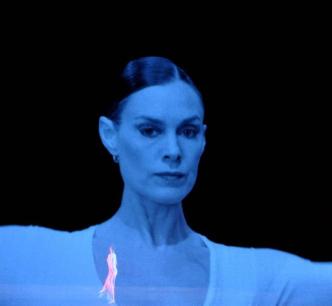MIWA & VIDEO PERFORMANCE
Incorporation of the body throughout her early work; imagining visually–like taking an egg out; reaching out through time and space like how would it feel touching the moon; surreal work; gestural place specifically with the physical body and the affect that that would have
not a story but a series of impressions that are physical and mental; physical connection to time and space; doesn’t use 3d meaning like no cartoon arms or anything so every physical thing is a little twitchy and off in a way; finding her idiosyncratic ways
group work: relationship between video and physical creating some kind of off mismatched feeling; broken up per scene so we can control perception but the music was live so it wasn’t moment for moment the same each time it was informed by the performer and the video; now it’s more prerecorded with some live music again goes per scene;
working a lot on gaze–the performer can’t be looking at the screen but rather seeing past the mountain in the distance; creating a pretend connection between the media and the performer
JOSH & LIGHTING
lighting is usually following; there’s a way in which he feels his way through and then arrive at the other side knowing how it’s supposed to look; the final product is in the space–everything happens there…you can move the dance you can listen wherever but with lighting its now or never in that space; want to discover it when you get into the space;
it is the feeling of the piece, the particular look, the cue. 2 types of cues: music cues or movement cues; how do you pick which to go off of? off of the music more in regard to tone but the movement more in regards to specifics–usually the music is a very serious grounding force has been added in to what’s occurring so it informs the mood of what’s happening it’s going to be a different feeling over all; making choices–he can’t tell you why but it just feels right, to everyone
costume and lighting: the color matters; the costume can limit the lights and vice versa
lighting and dance; lighting is supposed to inform but not distract from the pieces; lighting helps them watch the dance
ETHEL
Physicality of rhythm is an essential part of music; the weight that you give to one beat versus the lift you give to another beat; creativity is this burning thing that it was it is and danced has resisted being divided and physically taken down like music on a page–to explain what you want is impossible without just doing it;
MARY ELLEN CHILDS
running ideas by the composer and then she placed and wrote the movement; and the choreography came next; or a solo flute piece with lots of movement or at least something to look at; music behind the audience and the movement; sometimes it’s just not the right relationship and you have to walk away; she doesn’t believe in an actual equal relationship because someone has to start it–being the lead or being a follower and neither is less but still working together


